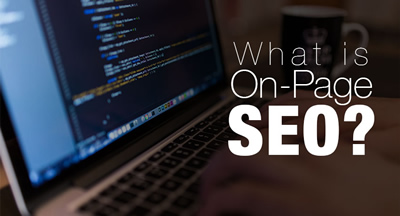On-Page Optimization
 On-Page SEO is the practice of optimizing individual web pages on order to rank higher and earn more relevant traffic in search engines. On-page SEO also refers to both the content and HTML source code of a page that can be optimized using best practices.
On-Page SEO is the practice of optimizing individual web pages on order to rank higher and earn more relevant traffic in search engines. On-page SEO also refers to both the content and HTML source code of a page that can be optimized using best practices.
This incorporates all aspects of the webpage that, when combined, will improve the page’s rankings in the search results. As Google becomes more sophisticated, relevance becomes one of the major factors influencing on-page optimization. How relevant your page content responds to a query is crucial when it comes to developing the page.
Relevance of content will generally have about eight seconds to influence a visitor to interact with a website. The more interaction and engagement, coupled with the duration of time that users stay on the site, the better their experience.
If a well planned effort is invested into the categories and strategies of on-page SEO, a boost in traffic and a rise in your search presence will result.
Meta Tags
Meta tags are used to provide search engines with information about your page. To achieve high rankings, it has to do with relevance and user satisfaction. Including custom meta tags will influence users and increase your click-through-rate.
Title Tags
The title tag defines the page content. When ranking web pages for a given query, Google looks at the title tag and compares that to the rest of the content on the page. This is where relevancy is important to content. Headings should be used to structure the page to make sure the content supports the heading.
Complementing the title of the page with text used in the heading tags should provide users with a clear understanding of what the page is about. The search engine algorithm compares the section of content beneath each heading tag to establish relevancy.
Meta Description
The meta description identifies what users will find on the page. While not a specific ranking factor, search engines will read the meta descriptions to determine the page’s topic in order to respond to a given search. While there is a possibility that Google will omit the meta description and pull an excerpt of the content on the page, it is recommended that you include the meta description for every page of your site.
Heading Tags
The web site’s landing page or blog should include multiple heading tags. The most important is the h1. However, any given page should have only one h1 tag as this should be used for the main page title. It’s entirely proper to Include multiple h2’s or h3’s as users scroll down the page. These are used as subheadings.
The use of headings serves to represent different sections of the page, which will impact from both an SEO standpoint and a usability standpoint.
Content Factors
As an content factor for SEO, supplementing the title of the page with the text used in your heading tags will provide users with a concise view of the page content. Search engine algorithms compare the section of content below each heading tag to establish relevancy.
Headings should be used to construct the page. It is essential that the content supports the heading. The primary keyword of the page should be included in your h1 tag.
A popular tool is the Yoast SEO plugin used on WordPress sites. It provides an understanding of the strengths and weaknesses of each page. It analyzes on-page factors to make sure your page is fully optimized. As an added benefit, it alerts you of any issues or deficiencies with the page title, meta description, headings, images, content, and more.
For landing pages and some blogs, bear in mind that visitors are not reading the entire page. They’re scanning and browsing quickly, looking for content that interests them, answers questions or provides value.
Headings and subheadings may be used to split up the page, making the presentation look cleaner and improves readability. Subheadings help users navigate throughout the page. If you’re changing the subject or discussing a different aspect of the service, use h2s. If you break it down further and need a sub-sub-heading under an h2, use an h3 tag.
As Google crawls the page, it seeks to match user intent. Your content should clearly explain what product or service you’re offering, or the exact topic of the page.


